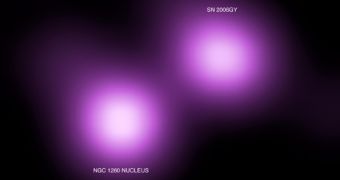SN 2006gy is the brightest supernova ever observed. It was first discovered last year, in the constellation Perseus, about 240 million light years away, when during an explosion it displayed a luminosity one hundred times more than a typical supernova. Since there is no theoretical explanation for this event, two teams of researchers have developed two competing theories.
The team led by Stan Woosley at the University of California, Santa Cruz proposes that the supernova arose from the sequential explosion of shell of matter inside a single supermassive star. The other team, led by Simon Portegies Zwart of the University of Amsterdam, Netherlands, suggests that the supernova was caused by the collision of two or more supermassive stars.
The team supporting the multiple collision theory, says that to cause such an explosion, a single star would have to have a mass of at least a hundred or more times. However, the spectral analysis shows that there is too much hydrogen in its chemical signature. Massive stars, more than 40 times that of the Sun, shed most of their hydrogen gas well before the supernova phase. 2006gy is situated in the core of its galaxy, near the center, were stellar collisions are more frequent. So the team proposed that a rich hydrogen star, with a mass of about 10 to 40 times that of the Sun collided into a supermassive star with a mass of one hundred times that of the Sun.
The collision would have infused large quantities of hydrogen into the massive star, thus explaining the hydrogen excess. If this theory is correct, then in a year or so a dense cluster of massive stars will become visible at the site of the supernova explosion.
The alternative theory supported by professor Stan Woosley implies that the supernova, cannot be accounted for, as a result of stellar collision, but rather through repeated explosions of an extremely massive star. Stars go through a process of explosion, during the phases of formation and depletion of fuel. The models describing the formation of a star similar to our Sun, suggest than only one supernova explosion will take place, to stabilize itself.
But supermassive stars trigger a mechanism of successive supernova explosions to shed excess material until it becomes stable, in the case of 2006gy this would have to occur at least six times. The first explosion throws the outer shell of excess matter, but does not produce a very bright display. The second supernova explosion will put energy into a second shell situated under the first one, and will expand until it collides with the first shell and produces extremely brilliant luminosity. The two colliding shells would have to collide at a distance at which the whole kinetic energy of the two will be transformed into light, to produce the observed luminosity in 2006gy. The usual conversion rate of the kinetic energy of a supernova into light is about one percent, because the shells would have to expand so much for light to have a chance to escape.
Researchers at the University of California say that for such a mechanism to be triggered, the mass of the single star would have to be at least 90 to 130 times that of the Sun. Towards the end of its life, the temperature at its core reaches levels at which part of the gamma-ray energy is converted into matter, of pairs of electrons and positrons, causing the radiation pressure to drop and the core to collapse rapidly.
The collapse of the core increases the instability, collapses and begins to burn fuel explosively. The star will then expand violently, but not enough to destroy the star, so stars with high masses pulse instead, until they shed enough matter to become stable.
The idea of pair instability has been suggested in the past by astronomers, but the mechanism of multiple explosions, called pulsational pair instability, is relatively new. Stars of this size are very rare, especially in our galaxy, but they might have been common in the early universe.

 14 DAY TRIAL //
14 DAY TRIAL //